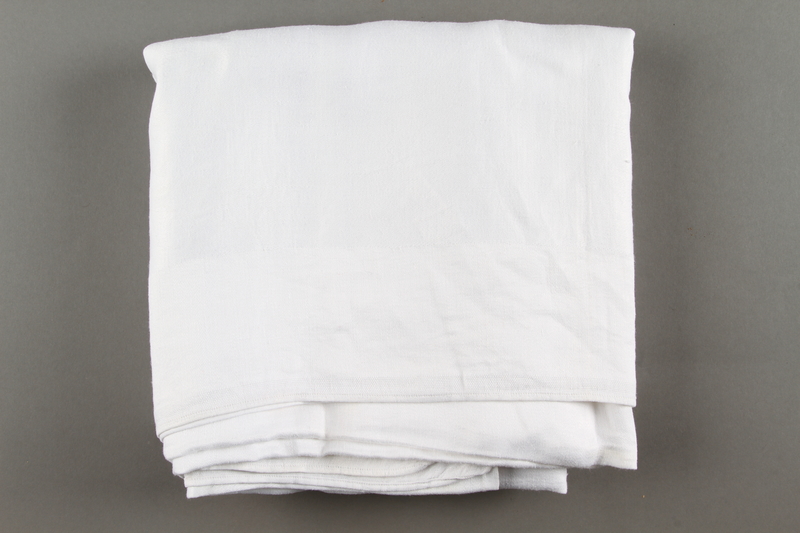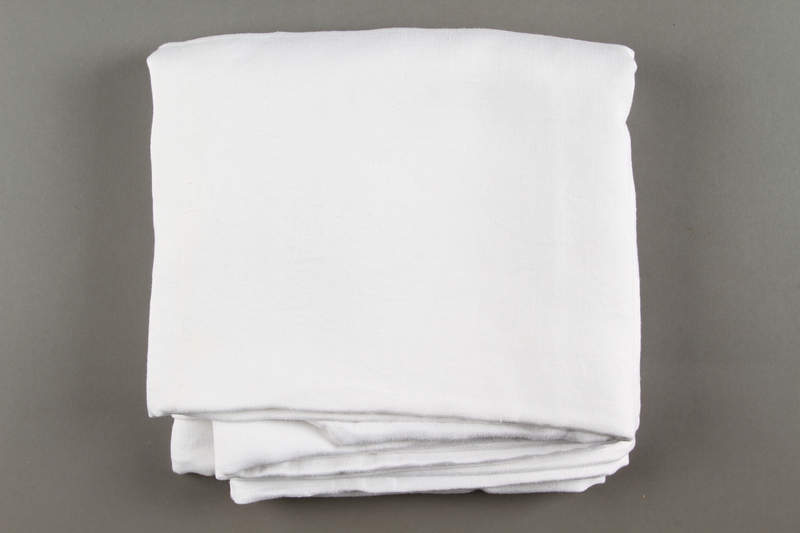Overview
- Brief Narrative
- Cotton napkin, embroidered with the initials of Otto and Edith Frank, gifted to them for their wedding on May 8, 1925. Otto and Edith had two daughters, Margot and Anne, and lived in Frankfurt, Germany. After Adolf Hitler was appointed chancellor of Germany in January 1933, authorities quickly began suppressing the rights and personal freedoms of Jews, and boycotting their businesses. Germany invaded the Netherlands on May 10, 1940, and under occupation, the Netherlands became subject to the Nuremburg laws. As restrictions continued to tighten, and antisemitism grew, Otto set up a hiding place in the attic of his business. The family moved into their hidden rooms on July 6, 1942, and were later joined by four others. Otto’s most trusted employees, including Miep and Jan Gies, immediately agreed to help them, at great risk to their own safety. The group was discovered and arrested in August 1944, and deported to Auschwitz-Birkenau killing center in German-occupied Poland. Margot and Anne were transferred to Bergen-Belsen concentration camp in Germany, where they both died from typhus in March 1945. Edith died in Birkenau on January 6, 1945. Otto was the only one of the group to survive the Holocaust, and he returned to Amsterdam in June 1945. While rebuilding his life, Otto contacted Fritzi Geireinger, a former neighbor whose daughter, Eva (later Schloss), he had met while in Auschwitz. Otto joined the rest of his family in Basel, Switzerland, in 1952, and married Fritzi the following year. Otto devoted the rest of his life to fighting for human rights and organized international youth conferences.
- Date
-
received:
1925 May 08
- Geography
-
use:
Frankfurt am Main (Germany)
use: Amsterdam (Netherlands)
- Credit Line
- United States Holocaust Memorial Museum Collection, Gift of Ryan M. Cooper
- Contributor
-
Subject:
Otto H. Frank
Subject: Edith H. Frank
Previous owner: Eva Schloss
- Biography
-
Otto Frank (1889-1980) was born in Frankfurt am Main, Germany, to Michael (1851-1909) and Alice Betty (nee Stern, 1865-1953) Frank. Otto had three siblings, Robert (1886-1953), Herbert (1891–1987), and Helene (later Elias, 1893-1986). Michael owned a bank, and the family lived a privileged lifestyle, practicing a liberal form of Judaism. The Frank children received a quality education, took music lessons, and attended the theater and opera with their parents.
After Otto graduated from high school, he spent a year at the University of Heidelberg and then moved to New York City for an internship at Macy’s department store. When Michael died in 1909, Alice took over the bank. Otto returned to Germany in 1911 to support his mother. He enlisted in the army in 1915, and worked in an analysis unit during World War I. By the end of the war in 1918, he had attained the rank of lieutenant and was awarded the Iron Cross for his service. After the war, Otto and his brothers joined the bank.
Otto married Edith Holländer (1900-1945) in Aachen on May 8, 1925. They settled in Frankfurt, and had two daughters, Margot (1926-1945) and Anne (1929-1945). In 1931, Otto’s sister, Helene, moved to Basel, Switzerland. There, her husband Erich Elias, established a branch of the pectin manufacturer Opekta-Werke (a subsidiary of Pomosin). In 1932, Otto’s brother, Herbert, immigrated to France.
On January 30, 1933, Adolf Hitler was appointed chancellor of Germany. Under Hitler, authorities began suppressing the rights of Jews, and boycotting their businesses. Shortly after, Otto and Edith moved their family to the Netherlands. Otto’s brother, Robert, immigrated to England. In October, Alice left Germany, and joined Helene in Basel.
After arriving in Amsterdam, Otto’s brother-in-law, Erich, helped him start a franchise of the Opekta company. Among his new employees were Johannes Kleiman (1896-1959), Victor Kugler (1900-1981), and Miep Santrouschitz (later Gies, 1909-2010). He also hired Bep Voskuijl (1919-1983) in 1937. The Franks were close with their employees, and often hosted guests at their home. In March 1939, Edith’s mother, Rosa (1866-1942), immigrated to the Netherlands and moved in with the Franks.
Otto started a second business, Pectacon, which sold herbs and spices. In 1939, he hired Hermann van Pels (1898-1944), a German-Dutch Jew who was knowledgeable about meat and sausage herbs. In 1941, he hired Johan Voskuijl (Bep’s father, 1892-1945), as Opekta’s warehouse manager.
Germany invaded the Netherlands on May 10, 1940. Under German occupation, the country became subject to the Nuremburg laws, which excluded Jews from citizenship, and mandated the separation of Jews and non-Jews. When the German administration required all Jews to register their business and assets, Otto managed to prevent the Nazis from seizing his company. Johannes Kleimann became the managing director of Opekta. Victor Kugler and Miep’s husband, Jan Gies (1905-1993; they married in July 1941), took over Pectacon under the name Gies & Co., with Jan as the supervisory director and Victor as manager.
In January 1941, the German authorities mandated the registration of all Jews residing in the Netherlands. Otto wanted to move his family to the United States, but was unable to collect the necessary paperwork. In April, Dutch Jews were required to start wearing the yellow Star of David. As restrictions continued to tighten, and antisemitism grew, Otto set up a hiding place in the attic of his business, which was later dubbed “the Secret Annex.” Johannes Kleimann helped him furnish it, and Johan Voskuijl built a bookcase to hide the entrance.
In the summer of 1942, German authorities began deporting Jews from the Netherlands, via the Westerbork transit camp. On July 5, Otto’s daughter, Margot, received a summons to report to a labor camp in Germany. The following day, the family moved into the Secret Annex. The following week, Hermann van Pels, along with his wife and son, Auguste (1900-1945) and Peter (1926-1945), joined them. In November, they added an eighth person, Fritz Pfeffer (1889-1944), a German Jewish dentist who became part of their social circle in 1940. Otto’s employees agreed to help them, risking their own safety. The helpers brought supplies, and worked to ensure that the business operated as usual, so as not to draw suspicion. Although Otto had officially turned his business over to his non-Jewish employees, he continued to be involved as much as possible. He would listen in on meetings through the floorboards and work in the office after the staff had left. With eight people hiding in a confined space, conflict often arose, and Otto did his best to maintain peace.
After two years of hiding, the annex was discovered by the authorities. The group was arrested on August 4, 1944, and taken to Westerbork transit camp. While there, Otto performed forced labor, while Edith, Margot, and Anne were forced to take old batteries apart for reuse. On September 3, they were all deported to Auschwitz-Birkenau killing center in German-occupied Poland. The men and women were separated after they arrived, and Otto, Hermann, and Fritz were assigned to forced labor. Otto initially worked in a gravel mine, then was later transferred to a crew that built roads outside of the camp. Hermann was killed in the gas chambers in October 1944. Peter was assigned a job in the camp post office, and was occasionally able to get Otto extra food. At one point, Otto was severely beaten, and was only admitted to the sick barracks after intervention by some of his fellow inmates.
In January 1945, Auschwitz was evacuated in advance of the Soviet arrival. Those able to walk were sent on a forced march, including Peter, but Otto had to remain in the sick barracks. He weighed 115 pounds and was too weak to join the march. Soviet forces entered the camp on January 27, 1945. Otto was nursed back to health, and then left for the Netherlands on February 23. While on the journey, he learned Edith died in the sick barracks at Auschwitz-Birkenau on January 6, 1945, three weeks before the camp was liberated.
Otto arrived in Amsterdam on June 3, and moved in with Miep and Jan Gies. The following month, he learned his daughters had died in Bergen-Belsen. Auguste van Pels died in April 1945 on a transport to Theresienstadt ghetto-labor camp in German-occupied Czechoslovakia. Fritz Pfeffer died in December 1944 at Neuengamme concentration camp. Peter van Pels died in the Mauthausen subcamp, Melk, in May 1945, only a few days after liberation. Otto was the only one of the eight who hid in the Annex to survive the Holocaust.
While trying to rebuild his life, Otto contacted Elfriede (Fritzi) Geireinger (1905-1998), a former neighbor whose daughter he had met while in Auschwitz. Fritzi and her daughter, Eva (later Schloss, b. 1929), had survived the Holocaust, but her husband and son had not. Otto stayed with the Gies’ until 1952, when he immigrated to Basel, Switzerland. The following year, he and Fritzi married.
During their time in hiding, Anne wrote about her experiences in papers, notebooks, and a diary. Miep saved them when the Annex was raided and gave them to Otto. Two years after the war, Otto had the diary published, and the first edition, titled “Het Achterhuis,” was released in the summer of 1948. Otto regularly corresponded with readers of Anne’s diary, and became friends with some. He devoted the rest of his life to fighting for human rights and organized international youth conferences.
Edith Holländer (1900-1945) was born in Aachen, Germany, to Abraham and Rosa (nee Stern, 1866-1942) Holländer. She had three older siblings: Julius (1896-1967), Walter (1897-1968) and Bettina (1898-1914). Her family owned a business trading and recycling scrap metal, machinery, and appliances. As a result, the family was fairly wealthy. Although the family was very religious and kept Kosher, Edith attended the Evangelical Higher Girls’ School. When Edith was 14, her sister, Bettina, died of unknown causes. After she finished high school, Edith spent a few years working in the family business and had a lively social life.
Edith first met Otto Frank (1889-1980) at an engagement party of a mutual friend. The couple married in Aachen on May 8, 1925. They settled in Frankfurt, and had two daughters, Margot (1926-1945) and Anne (1929-1945). Although both Otto and Edith were Jewish, they raised their daughters in a secular household.
Otto worked for his family's banking business, founded in 1896 by his father. On January 30, 1933, Adolf Hitler was appointed chancellor of Germany. Under Hitler, authorities quickly began suppressing the rights and personal freedoms of Jews, and boycotting their businesses. Shortly after, Otto and Edith moved their family to the Netherlands. Edith’s family remained in Germany for the time being, while Otto’s mother and siblings immigrated to Switzerland, France, and England.
After arriving in Amsterdam, Otto’s brother-in-law, Erich, helped him start a franchise of the Opekta company. Among his new employees were Johannes Kleiman (1896-1959), Victor Kugler (1900-1981), and Miep Santrouschitz (later Gies, 1909-2010). He also hired Bep Voskuijl (1919-1983) in 1937. Edith and the girls stayed with her mother in Aachen until December 1933, when Edith and Margot joined Otto in Amsterdam. Anne remained in Aachen until February 1934. The family moved into an apartment just south of the city, in an area with many Jewish immigrants from Germany and Austria. Despite their new community, Edith had a hard time adjusting to life in the Netherlands. The Franks were close with their employees, and often hosted guests at their home.
In Germany, Edith’s family suffered from the ramifications of the Kristallnacht pogrom of November 1938. Her brothers were able to immigrate to the United States, and in March 1939, her mother, Rosa, immigrated to the Netherlands and moved in with the Franks. Otto started a second business, Pectacon, which sold herbs and spices. In 1939, he hired Hermann van Pels (1898-1944), a German-Dutch Jew who was knowledgeable about meat and sausage herbs. In 1941, he hired Johan Voskuijl (Bep’s father, 1892-1945), as Opekta’s warehouse manager.
Germany invaded the Netherlands on May 10, 1940. Under German occupation, the country became subject to the Nuremburg laws, which excluded Jews from citizenship, and mandated the separation of Jews and non-Jews. When the German administration required all Jews to register their business and assets, Otto managed to prevent the Nazis from seizing his company. Johannes Kleimann became the managing director of Opekta. Victor Kugler and Miep’s husband, Jan Gies (1905-1993; they married in July 1941), took over Pectacon under the name Gies & Co., with Jan as the supervisory director and Victor as manager.
In January 1941, the German authorities mandated the registration of all Jews residing in the Netherlands. Otto wanted to move his family to the United States, but was unable to collect the necessary paperwork. In April, Dutch Jews were required to start wearing the yellow Star of David. As restrictions continued to tighten, and antisemitism grew, Otto set up a hiding place in the attic of his business, which was later dubbed “the Secret Annex.” Johannes Kleimann helped him furnish it, and Johan Voskuijl built a bookcase to hide the entrance.
The following day, the family moved into the Secret Annex. The following week, Hermann van Pels, along with his wife and son, Auguste (1900-1945) and Peter (1926-1945), joined them. In November, they added an eighth person, Fritz Pfeffer (1889-1944), a German Jewish dentist who became part of their social circle in 1940. Otto’s employees agreed to help them, risking their own safety. The helpers brought supplies, and worked to ensure that the business operated as usual, so as not to draw suspicion. Edith often clashed with her strong-willed daughter, Anne, but their relationship improved somewhat as Anne matured.
After two years of hiding, the annex was discovered by the authorities. The group was arrested on August 4, 1944, and taken to Westerbork transit camp. While there, Otto performed forced labor, while Edith, Margot, and Anne were forced to take old batteries apart for reuse. On September 3, they were all deported to Auschwitz-Birkenau killing center in German-occupied Poland. The men and women were separated after they arrived. Anne, Margot, and Edith were able to remain together for two months, before Anne had to be moved to the isolation block. Margot accompanied her there.
In late October 1944, Anne and Margot were selected for a labor detail, and transferred to Bergen-Belsen concentration camp in Germany. Edith became ill and was admitted to the sick barracks. She died on January 6, 1945, three weeks before the camp was liberated. Her daughters died a couple months later in Bergen-Belsen. Auguste van Pels died in April on a transport to Theresienstadt ghetto-labor camp in German-occupied Czechoslovakia. Hermann van Pels was killed in the gas chambers in October 1944. Fritz Pfeffer died in December 1944 at Neuengamme concentration camp. Peter van Pels died in the Mauthausen subcamp, Melk, in May 1945, days after liberation. Otto was the only one of the eight who hid in the Annex to survive the Holocaust.
Eva Geiringer (later Schloss, b. 1929) was born in Vienna, Austria, to Erich (1901-1945) and Elfriede (Fritzi) Markovits (1905-1998) Geiringer, who married in 1923. She had an older brother, Heinz (1926-1945), and they had a very close relationship. Fritzi’s parents lived very close by, and they saw each other every couple of days. Erich was a shoe manufacturer, and exported moccasins until 1934, when The Great Depression caused his firm to go bankrupt. The family moved to a less expensive area of Vienna. During this time, Erich was able to find new business opportunities and worked with connections in the Netherlands, where he began building up capital.
On March 13, 1938, Austria was annexed into Germany, in what became known as the "Anschluss." Austria became subject to the Nuremberg Laws, which suppressed the rights and personal freedoms of Jews. Eva and Heinz were no longer allowed to attend public school, and had to transfer to a Jewish school, even though Eva never truly identified as Jewish. The Geiringers decided to flee. Erich left first for the Netherlands, followed soon by Heinz. By the time Fritzi and Eva were ready to follow, the Dutch borders had closed. Instead, they snuck into Belgium, where Erich could visit them on weekends. They found a boarding house, and Eva began attending a girls’ school, where she learned French and made new friends.
The desire to reunite intensified after World War II began in September 1939. Erich was able to obtain a visitation permit so his family could enter the Netherlands, and they joined him in Amsterdam in February 1940. They settled in an area where many other refugees lived, and moved into a building across the street from the Frank family. Eva and Heinz went to the same school as Anne and Margot Frank.
The Germany invaded the Netherlands on May 10, 1940. Under German occupation, the Netherlands also became subject to the Nuremburg laws. Once again, Heinz and Eva had to stop attending the public school. Heinz was enrolled in a Jewish school, while Eva shared a private tutor with several other children. Erich had to close his business, but opened a small workshop making snakeskin handbags. By January 1941, all Jews had to register with the authorities. That spring, thousands of Jews were sent to German-run forced labor camps. Eva's father began to make plans to go into hiding. The underground supplied the family with false papers, and Eva was given the false identity of a Christian named Jopie Ackerman.
In the summer of 1942, German authorities began deporting Jews from the Netherlands, via the Westerbork transit camp. After Heinz and his neighborhood peers received a summons to report for a labor camp in Germany, on July 5, 1942, the family decided to go into hiding. Erich felt they would be safer if the family split up. For their first placement, Eva and her mother hid in the home of a woman who had two young sons. When the danger became too great, they moved into the home of Mrs. Klompe, a teacher. Resistance members built a false tile wall behind the toilet for an extra hiding space. Two hours after it was finished, German police raided the apartment, but did not find Eva and her mother.
Eva and Fritzi both had blond hair and could pass as non-Jewish, so they were able to leave the apartment occasionally to visit Erich and Heinz. Heinz looked stereotypically Jewish, so the men did not dare to leave their hiding space and occupied themselves by painting, writing, and studying languages. Hiding them was riskier, because the neighbors of their rescuer were Dutch Nazis. After a while, their rescuers grew tired of hiding them, fed them less, and demanded more money. The Germans increased efforts to find hidden Jews, and all four family members were moved to new hiding places.
Eva and Fritzi moved in with the Reitsma family, who prepared a special birthday breakfast for Eva’s 15th birthday on May 11, 1944. Just as they were finishing, the Gestapo burst into the home. They had been turned in by a Dutch nurse who had helped Erich and Heinz get to their new hiding place. Eva and Fritzi were taken to a detention center, as were Erich, Heinz, and the Reitsmas. All four members of the Geiringer family were beaten or tortured during their interrogation. Erich offered the Gestapo jewelry in exchange for freeing the Reitsmas. The Reitsmas were released, but the Geiringers were sent to Westerbork transit camp. After a few days, they were deported to Auschwitz-Birkenau killing center in German-occupied Poland, arriving on May 17.
The men and women were separated on the train platform after they arrived. During the processing, Eva was tattooed with the number A5272, and had her head shaved. They were forced into showers, given uniforms, and sent to barracks where ten people had to sleep to a bunk. After three weeks in new-arrival quarantine, Eva and Fritzi were assigned to a work detail in the Kanada barrack, sorting clothes and personal possessions. At one point, Eva and Fritzi went to the hospital block and met a nurse, Minni, who happened to be Fritzi’s cousin. Minni’s position enabled her to give them extra food and medicine. Eva’s father, Erich, tracked her down, and they were able to meet twice at a camp fence. Talking through the fence, Erich told her that he was working in a timber factory and Heinz was assigned to the vegetable gardens.
Eva and Fritzi worked in the warehouse from May to July 1944. Afterwards, they were reassigned to hard physical labor, carrying heavy stones. In September, Fritzi was selected for the gas chambers. Eva was given a new labor assignment to braid ropes. After two months, Eva met a group of Dutch Jews who told her that Minni persuaded Dr. Mengele to spare Eva’s mother. Eva was admitted to the hospital block where her mother was hiding, and Minni got her transferred so she could stay.
In January 1945, Birkenau was evacuated in advance of the Soviet arrival. Those able to walk, including Minni, were sent on a forced march. After the SS fled, Eva raided the storerooms for food, clothing, and blankets. A few days later, Soviet soldiers arrived. Eva and a friend and walked to the main camp where they reunited with male survivors. Eva saw her former neighbor, Otto Frank (1889-1980), who informed her that Erich and Heinz had been on the forced march. Eva fetched her mother from Birkenau, and they settled into the men’s camp.
In February, the Soviet soldiers transported the survivors to Katowice, Poland, then to Cernauti, Romania (Chernivtsi, Ukraine) and finally to Odessa, Ukraine, where they stayed until the war ended in May. Eva and Fritzi then made their way back to Amsterdam. They received a letter from the Red Cross telling them that Heinz had died at Mauthausen in April 1945, and that Erich died on May 4, three days before the war ended. Fritzi began working in an office, while Eva returned to school and began working part-time in a photography and printing studio. Eva and Fritzi became close with Otto Frank, who had also returned to their neighborhood in Amsterdam. In 1951, he arranged for Eva to study photography in England for a year. While there, she met and began dating an Israeli economic student, Zvi Schloss. Eva married Zvi in 1952, and the following year, her mother married Otto Frank and relocated to Basel, Switzerland. Eva and Zvi settled in London, and they had three daughters.
Physical Details
- Classification
-
Furnishings and Furniture
- Category
-
Household linens
- Object Type
-
Napkins (lcsh)
- Genre/Form
- Table settings & decorations.
- Physical Description
- Rectangular, white, satin weave, cotton napkin with a damask pattern and a hand-embroidered monogram in one corner. There are two selvedge edges, as well as two machine-stitched, hemmed edges. The napkin has an intricate tone-on-tone pattern, created by alternating warp and weft facing weaving. The narrow pattern that borders the edge consists of a two ribbons in a double helix interspersed with four-lobed flowers. Just inside the border, a large floral element is placed in each corner, separated on each side by three large, ornate urns decorated with flowers and ribbons. Connecting each urn is a floral swag, below which a small floral element sits along the border. The central design consists of nine, evenly-spaced vertical stripes, broken up wreaths with a bow at the bottom. The wreaths are offset, alternating between two and three wreaths per stripe. In the top left corner, placed upside down, is a raised whitework monogram, hand-embroidered in a satin stitch. Three script initials sit inside an elliptical shape with points at the top, bottom, and sides. To the outside of each point is a beaded chevron that creates the impression of a diamond shape. The reverse side of the embroidery is almost as tidy as the front.
- Dimensions
- overall: Height: 25.000 inches (63.5 cm) | Width: 25.375 inches (64.453 cm)
- Materials
- overall : cotton, thread
- Inscription
- top left corner, hand-embroidered, white thread : OFE [Otto and Edith Frank]
Rights & Restrictions
- Conditions on Access
- No restrictions on access
- Conditions on Use
- No restrictions on use
Keywords & Subjects
- Topical Term
- Antisemitism--Germany. Families. Hiding places--Netherlands--Amsterdam. Jewish children in the Holocaust. Holocaust survivors--Family relationships. Holocaust survivors--Marriage. Jewish families. Jewish refugees--Europe.
- Geographic Name
- Amsterdam (Netherlands) Basel (Switzerland) Frankfurt am Main (Germany) Oswiecim (Poland)
- Personal Name
- Frank, Otto, 1889-1980. Schloss, Eva.
Administrative Notes
- Legal Status
- Permanent Collection
- Provenance
- The napkin was donated to the United States Holocaust Memorial Museum in 2018 by Ryan M. Cooper, a friend of Otto Frank.
- Record last modified:
- 2022-09-12 10:15:28
- This page:
- https://collections.ushmm.org/search/catalog/irn652081
Also in Ryan M. Cooper collection
The collection consists of table linens, a mustard pot, coin purse, suitcase, book, correspondence, newspaper clippings, photographs, documents, and an audio recording relating to the experiences of Otto Frank, Edith Frank, Fritzi Frank, Herbert Frank, Miep Gies, Jan Gies, Bep Voskuijl, and Victor Kluger in Frankfurt, Germany, Amsterdam, Netherlands, and Basel, Switzerland, before, during, and after the Holocaust.
Date: after 1800-1980
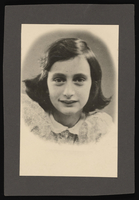
Ryan M. Cooper papers
Document
The Ryan M. Cooper papers consist of photographs of Anne Frank and her diary as well as correspondence to Ryan Cooper from Otto and Fritzi Frank, Miep Gies, Herbert Frank, Victor Kugler, and Bep Voskuijl. Anne Frank photographs include two items Otto Frank gave to Ryan Cooper. One is a photograph of Anne Frank at age 10 mounted on black photograph album paper. The image was cut out of one of the Frank family photo albums, and Frank gave it to Cooper in 1977. The other item is a printer’s mechanical paste-up of photographs of various foreign editions of Anne’s diary, a sketch of the outside of 263 Prinsengracht, and small pencil notes in German believed to be written by Otto Frank. Frank gave this item to Cooper in 1973. Otto Frank materials include letters and cards from Otto Frank and his second wife Elfriede “Fritzi” Frank to Ryan Cooper. The letters and cards include advice to Cooper about religion, work, and romance; information about the Anne Frank House and Anne Frank Foundation; planning for Cooper’s trips to Europe; news about the couple’s lives, travels, and health; and thoughts about Anne Frank’s legacy. The letters dated October 15, 1975; March 29, 1977; July 22, 1990; and February 12, 1992 are accompanied by enclosures including a photograph and two poems, a clipping, an Anne Frank commemorative postage stamp, and two additional photographs. Miep Gies materials include letters and greeting cards from Miep Gies conveying warm greetings, advice, and news about her life. This series also includes photographs of Gies, information about her cremation, and a copy of one of her speeches about Anne Frank. The collection includes additional correspondence to Cooper from Otto Frank’s younger brother Herbert Frank as well as Victor and Lucy Kugler and Bep Voskuijl, who helped conceal the Frank family in hiding. The letters and cards convey greetings, travel and health news, and their thoughts on Anne’s legacy.
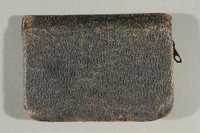
Coin purse owned by Otto Frank
Object
Change purse owned by Otto Frank. Otto was a German Jewish businessman who immigrated to Amsterdam, Netherlands, with his wife, Edith, and daughters, Margot and Anne. Germany invaded the Netherlands on May 10, 1940. Under German occupation, antisemitic restrictions were enforced, and Otto set up a hiding place in the attic of his business. The family moved into their hidden rooms on July 6, 1942, and were later joined by four others. Otto’s most trusted employees, including Miep and Jan Gies, immediately agreed to help them, at great risk to their own safety. Otto’s most trusted employees, including Miep and Jan Gies, immediately agreed to help them, at great risk to their own safety. While in hiding, Anne documented her thoughts and the group’s daily activities in a diary. In late March 1944, she began editing her diary and notebooks, with the goal of publishing it after the war. After two years, the hiding place was raided on August 4, 1944. The group was arrested and imprisoned in Westerbork transit camp. On September 3, they were all deported to Auschwitz-Birkenau killing center in German-occupied Poland, where Otto was assigned to forced labor. In January 1945, Auschwitz was evacuated in advance of the Soviet arrival. Prisoners able to walk were sent on a forced march. However, Otto was in the sick barracks at the time, ill and underweight. Soviet forces entered the camp on January 27, 1945, and Otto was nursed back to health. Otto was the only member of the hidden group to survive the Holocaust. He returned to Amsterdam on June 3, 1945, and moved in with Miep and Jan Gies. Miep gave Otto some personal possessions, including Anne’s diary, which she had saved. He found a publisher for the diary, which became well known worldwide. Otto devoted the rest of his life to fighting for human rights and organized international youth conferences.
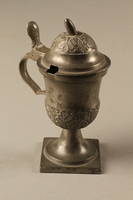
Pewter mustard pot owned by Otto Frank
Object
Pewter mustard pot owned by the Frank family. Otto Frank was one of three children born to Michael and Alice Frank in Frankfurt am Main, Germany. He had three siblings, Robert, Herbert, and Helene. Michael had founded a family banking business, which his wife and sons took over after his death in 1909. Helene moved to Basel, Switzerland, with her husband in 1931, and Herbert immigrated to France in 1932. After Adolf Hitler was appointed chancellor of Germany in January 1933, authorities quickly began suppressing the rights and personal freedoms of Jews, and boycotting their businesses. Shortly thereafter, Robert immigrated to England, and Otto immigrated to the Netherlands with his wife, Edith, and two daughters, Anne and Margot. In October 1933, Alice joined Helene in Basel. The Netherlands was invaded by Germany in May 1940, and Otto’s family went into hiding in July 1942. They were discovered and arrested in August 1944, and deported to Auschwitz-Birkenau killing center in German-occupied Poland. Otto was the only one of the four to survive the Holocaust, and returned to Amsterdam in June 1945. While rebuilding his life, Otto married Fritzi Geireinger, a former neighbor whose daughter he had met while in Auschwitz. Otto joined the rest of his family in Basel in 1952, and married Fritzi the following year. Otto published the diary his daughter, Anne, had used to document their time in hiding, and devoted the rest of his life to fighting for human rights and organized international youth conferences.
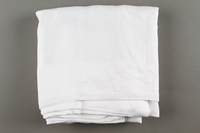
Monogrammed tablecloth owned by Otto and Edith Frank
Object
Cotton tablecloth, embroidered with the initials of Otto and Edith Frank, gifted to them for their wedding on May 8, 1925. Otto and Edith had two daughters, Margot and Anne, and lived in Frankfurt, Germany. After Adolf Hitler was appointed chancellor of Germany in January 1933, authorities quickly began suppressing the rights and personal freedoms of Jews, and boycotting their businesses. Germany invaded the Netherlands on May 10, 1940, and under occupation, the Netherlands became subject to the Nuremburg laws. As restrictions continued to tighten, and antisemitism grew, Otto set up a hiding place in the attic of his business. The family moved into their hidden rooms on July 6, 1942, and were later joined by four others. Otto’s most trusted employees, including Miep and Jan Gies, immediately agreed to help them, at great risk to their own safety. The group was discovered and arrested in August 1944, and deported to Auschwitz-Birkenau killing center in German-occupied Poland. Margot and Anne were transferred to Bergen-Belsen concentration camp in Germany, where they both died from typhus in March 1945. Edith died in Birkenau on January 6, 1945. Otto was the only one of the group to survive the Holocaust, and he returned to Amsterdam in June 1945. While rebuilding his life, Otto contacted Fritzi Geireinger, a former neighbor whose daughter, Eva (later Schloss), he had met while in Auschwitz. Otto joined the rest of his family in Basel, Switzerland, in 1952, and married Fritzi the following year. Otto devoted the rest of his life to fighting for human rights and organized international youth conferences.
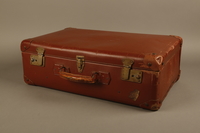
Vulcanized fiber suitcase owned by a member of the Frank family
Object
Vulcanized fiber suitcase owned by a member of the Frank family, likely Herbert. Herbert Frank was one of three children born to Michael and Alice Frank in Frankfurt am Main, Germany. He had three siblings, Robert, Otto, and Helene. Michael had founded a family banking business, which his wife and sons took over after his death in 1909. Helene moved to Basel, Switzerland, with her husband in 1931, and Herbert immigrated to France in 1932. After Adolf Hitler was appointed chancellor of Germany in January 1933, authorities quickly began suppressing the rights and personal freedoms of Jews, and boycotting their businesses. Shortly thereafter, Otto immigrated to the Netherlands with his wife and two daughters, and Robert immigrated to England. In October 1933, Alice joined her daughter in Basel. In summer 1942, German occupation authorities in France began mass arrests, internment, and deportation of Jews. Herbert was arrested and held in Gurs internment camp in southwestern France. He decided to immigrate to Switzerland, arriving on October 15, 1942. Otto was in hiding with his wife and daughters for two years, until they were discovered, arrested, and deported to Auschwitz-Birkenau killing center in August 1944. Otto was the only member of his family to survive the camps, and returned to Amsterdam after the war. Herbert lived in Switzerland until 1945, when he returned to Paris. Otto immigrated to Switzerland in 1952. Herbert moved to Basel permanently in 1955, and remained close with his family until his death.
Greetings from Otto and Fritzi Frank
Recorded Sound
First edition of Anne Frank’s Het Achterhuis given to a Dutch couple
Object
One of two copies of the first edition of Anne Frank’s “Het Achterhuis” (“The Secret Annex”), given to Miep and Jan Gies by Anne’s father, Otto Frank. The book includes the original dust jacket and protective clamshell case, and was one of 1500 copies printed in the first run. Anne Frank was a German Jewish girl who immigrated to Amsterdam, Netherlands, with her parents, Otto and Edith, and older sister, Margot. Germany invaded the Netherlands on May 10, 1940. Under German occupation, antisemitic restrictions were enforced, and Otto set up a hiding place in the attic of his business. The family moved into their hidden rooms on July 6, 1942, and were later joined by four others. Otto’s most trusted employees, including Miep and Jan Gies, immediately agreed to help them, at great risk to their own safety. While in hiding, Anne documented her thoughts and the group’s daily activities in a diary. In late March 1944, she began editing her diary and notebooks, with the goal of publishing it after the war. After two years, the hiding place was raided on August 4, 1944. The group was arrested and imprisoned in Westerbork transit camp. On September 3, they were all deported to Auschwitz-Birkenau killing center in German-occupied Poland. In late October 1944, Anne and Margot were transferred to Bergen-Belsen concentration camp in Germany. Both Anne and Margot died of typhus in March 1945. Anne’s father, Otto, was the only member of the group to survive the Holocaust. He returned to Amsterdam on June 3, 1945, and moved in with Miep and Jan Gies. After learning of Anne’s death, Miep gave Otto Anne’s diary, notebooks, and papers that she had salvaged from the annex in 1944. Two years after the war, Otto found a publisher for the diary, and the first edition, titled “Het Achterhuis,” was released in the summer of 1948.

